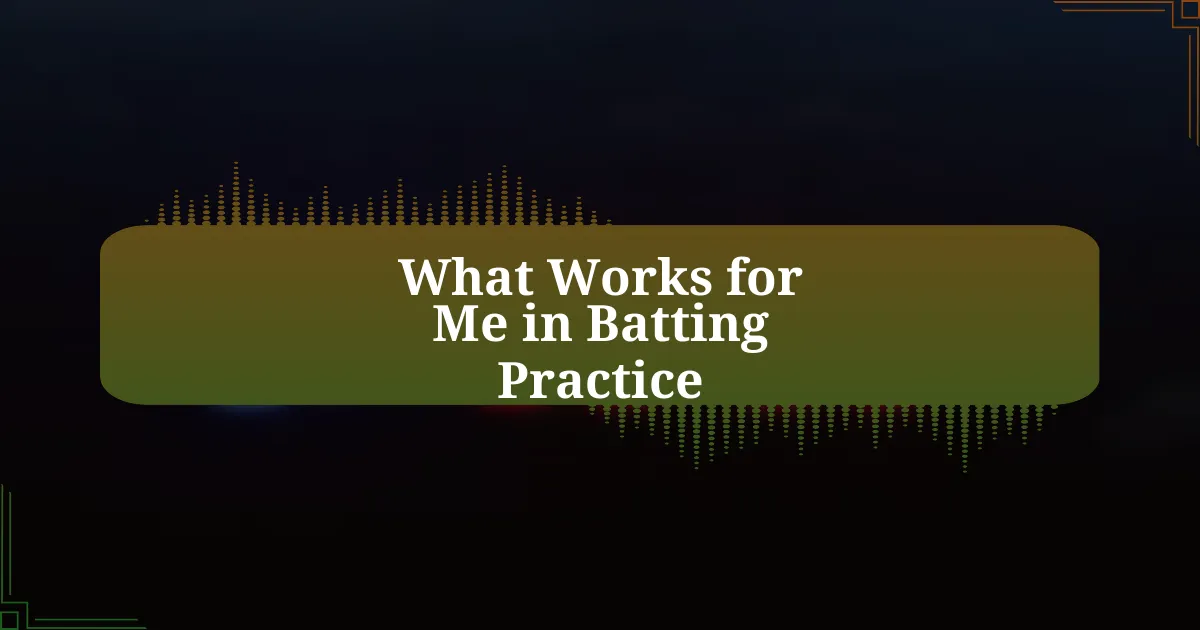Key takeaways:
- Structured practice focusing on specific skills like footwork and shot selection significantly enhances performance.
- Mimicking game scenarios during practice, along with maintaining a positive mindset, boosts readiness and confidence.
- Key batting techniques include refining grip, controlling backswing, and visualizing shots to improve execution.
- Tracking progress through notes and video analysis, along with setting specific goals, fosters continuous improvement.
Author: Evelyn Harper
Bio: Evelyn Harper is an award-winning author known for her evocative storytelling and rich character development. With a background in psychology, she weaves intricate narratives that explore the complexities of human relationships. Her debut novel, “Whispers in the Wind,” received critical acclaim and established her as a fresh voice in contemporary fiction. A graduate of the Iowa Writers’ Workshop, Evelyn resides in Portland, Oregon, where she continues to write and inspire aspiring authors through workshops and mentorship. When not immersed in her writing, she enjoys hiking the Pacific Northwest trails and sipping coffee at local cafes.
Understanding amateur cricket practice
Understanding amateur cricket practice is pivotal for any budding cricketer. I remember my first practice session, feeling both excited and anxious. The sight of the pitch and the sounds of clashing bats and balls filled me with anticipation, but I quickly learned that practice made a huge difference in my performance.
Many amateur players, like myself, often overlook the importance of a structured routine. I used to show up to every practice without a clear plan, thinking that just being there was enough. It wasn’t until I started focusing on specific skills like footwork and shot selection that I truly saw improvement. This raises an interesting question: How can we be sure we’re making the best use of our precious practice time?
I’ve also found that camaraderie in practice sessions can be just as important as the drills themselves. Laughing with teammates while trying out new techniques creates a relaxed atmosphere, enhancing my learning and making every session enjoyable. Have you ever felt that community spirit lift your mood during practice? It’s moments like those that make all the effort worthwhile, reminding us why we cherish this game.
Importance of effective batting practice
Effective batting practice is crucial for any amateur player looking to elevate their game. I vividly recall a session when I dedicated an entire hour solely to focusing on my footwork with a coach. The result? I felt more confident at the crease and saw immediate benefits in my match performances. Isn’t it amazing how targeted practice can turn practice time into a game-changer?
When you think about it, effective practice should mimic game scenarios as closely as possible. I remember incorporating drills that had me facing bowlers with different speeds and styles, and those moments forced me to adapt quickly. This not only enhanced my reaction times but also prepared me mentally for high-pressure situations. Don’t you agree that simulating real-game conditions can drastically improve your readiness for matches?
Moreover, the passion for improvement should be fueled by the right mindset during practice. I used to focus primarily on what I was doing wrong rather than celebrating the small victories. Shifting this perspective helped me enjoy the process more and gave me the motivation to push through the challenging moments. How do you maintain a positive outlook during those tough practice days?
Key techniques for better batting
When working on my batting technique, one of the key adjustments I embraced was refining my grip on the bat. I had always held it too tightly, which limited my wrist flexibility, affecting my stroke play. Gradually, I learned to relax my grip; this not only improved my timing but also made me feel more fluid at the crease. Have you ever noticed how a simple change can lead to a world of difference in performance?
Another technique that stands out in my practice is focusing on my backswing. I used to rush this part, often leading to poor shot execution. It wasn’t until a mentor highlighted the importance of a controlled and deliberate backswing that I started seeing the benefits. Now, I take an extra moment to ensure that my bat rises smoothly into position, feeling balanced and ready. Isn’t it interesting how taking just a fraction of a second more can lead to greater control?
I can’t stress enough the significance of visualizing my shots before I execute them. On days when my performance dipped, I began to mentally rehearse each ball, picturing the perfect shot before facing it. This mental practice not only improved my focus but also helped me recognize my scoring opportunities better. Have you ever tried this approach? It’s astonishing how much clarity it can bring to your batting!
Equipment that enhances my practice
Using the right equipment is vital to getting the most out of my batting practice. One piece of gear that has transformed my sessions is a quality cricket bat that feels like an extension of my hands. I remember the first time I picked up a bat that was perfectly balanced for me; every shot felt effortless, and my confidence surged. Have you ever experienced that moment when the right tool just elevates your game?
In addition to my bat, I’ve also invested in various training aids. One of my favorites is the batting tee, which helps me focus on my stance and shot placement without the pressure of a bowler. Initially, I was skeptical about practicing without a live ball, but it opened up a whole new world of control and consistency. Isn’t it rewarding to realize that sometimes, slowing things down can lead to faster improvement?
Another essential item in my practice routine is a set of weighted balls. These have seriously improved my strength and timing. I remember the first time I used them; the added weight initially threw me off balance, but over time, my timing became sharper and my shots more powerful. Have you noticed how pushing your limits with extra resistance can yield incredible results?
My favorite drills for improvement
My favorite drills for improvement
One drill that has significantly shaped my batting skills is the shadow batting exercise. I remember the first time I stood in front of a mirror, mimicking my favorite players’ strokes. It felt a bit silly at first, but seeing my technique visually reinforced what I needed to adjust. Have you ever tried practicing without actually hitting a ball? Sometimes, just focusing on form can be incredibly enlightening.
Another staple in my practice routine is the variation of throwdowns. I love having a partner who can pitch balls at different angles and speeds. Early in my cricket journey, I was intimidated by bouncers, but consistent practice prepared me to handle them effectively. It’s fascinating how facing unpredictable deliveries can sharpen your reflexes and decision-making during real matches. Isn’t it amazing how addressing weaknesses head-on can transform your confidence?
Lastly, I can’t overlook the importance of target batting drills. Setting up specific zones on the pitch pushes me to aim for precision, and that really helps me focus. Once, during a particularly intense session, I aimed for the offside boundary and found myself relentlessly driving balls with pinpoint accuracy. Have you ever felt that sense of satisfaction when you hit your target consistently? It’s those small victories that keep me motivated and continuously improving.
How I track my progress
Tracking my progress is essential to understanding my growth as a cricketer. I keep a dedicated notebook where I jot down observations after each practice session. It may seem basic, but writing things down creates a tangible record of my improvements. Have you ever realized how easy it is to overlook small wins? When I look back, those little notes remind me of my journey.
I also rely on video analysis to scrutinize my technique. Filming my batting has been a game-changer for me. The first time I saw myself play back, I was shocked at some of my habits. Those visual insights help me pinpoint what needs adjustment, making it clear what I need to focus on in future sessions. Have you found that seeing yourself in action alters your perspective?
Moreover, I make it a habit to set specific goals for each practice. Recently, I aimed to improve my shot selection during throwdowns, and by the end of the week, I could feel the difference. It’s incredible how having a clear target not only fuels my motivation, but it also makes measuring progress much more straightforward. Don’t you find that goals can act as a compass, guiding you on your path to improvement?
Lessons learned from my experiences
Lessons learned from my experiences
One of the biggest lessons I’ve picked up along my batting journey is the importance of patience. I remember a practice session where I struggled to find my rhythm. Instead of rushing through my drills, I allowed myself the time to really focus on each shot. This shift in mindset made a huge difference; I learned that improvement doesn’t always come quickly, and giving myself room to grow is crucial. Have you ever felt the frustration of wanting instant results?
I’ve also discovered that embracing failure is an essential part of growth. There was a memorable game where I faced a bowler who had me in knots. I walked away feeling defeated, but upon reflection, I realized that those tough moments taught me the most about my weaknesses. They’re like little teachers, nudging me toward greater resilience. Isn’t it fascinating how setbacks can provide the best learning opportunities?
Finally, I’ve learned to value feedback from teammates and coaches. Early on, I was hesitant to ask for their opinions, thinking I could figure everything out on my own. But when I finally did seek advice, I found their perspectives were invaluable. After a recent game, a teammate pointed out a slight flaw in my stance, and working on that suggestion helped me significantly in the next outing. Have you ever overlooked the wisdom of those around you? Sometimes, the best insights come from those who simply see us in action.



